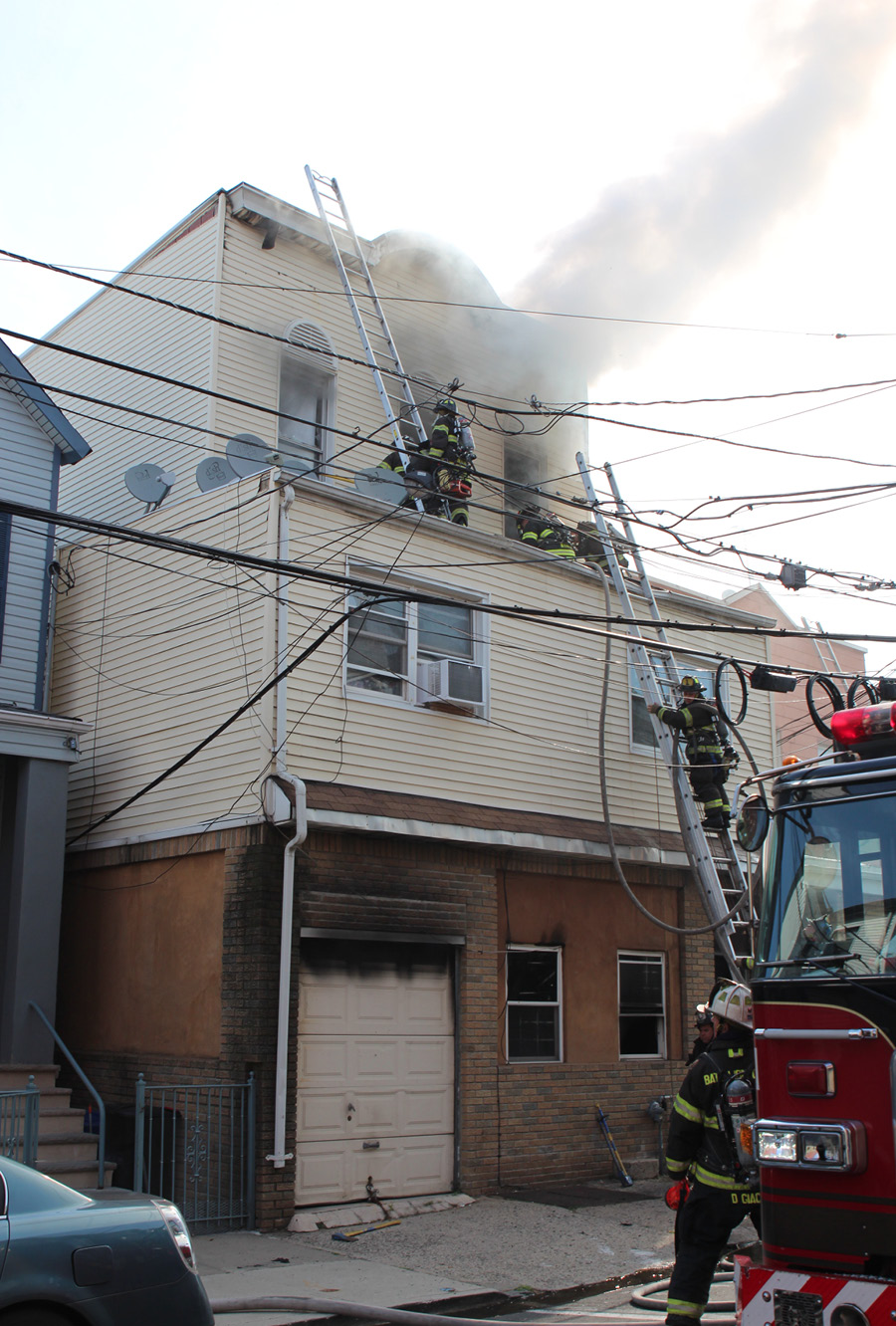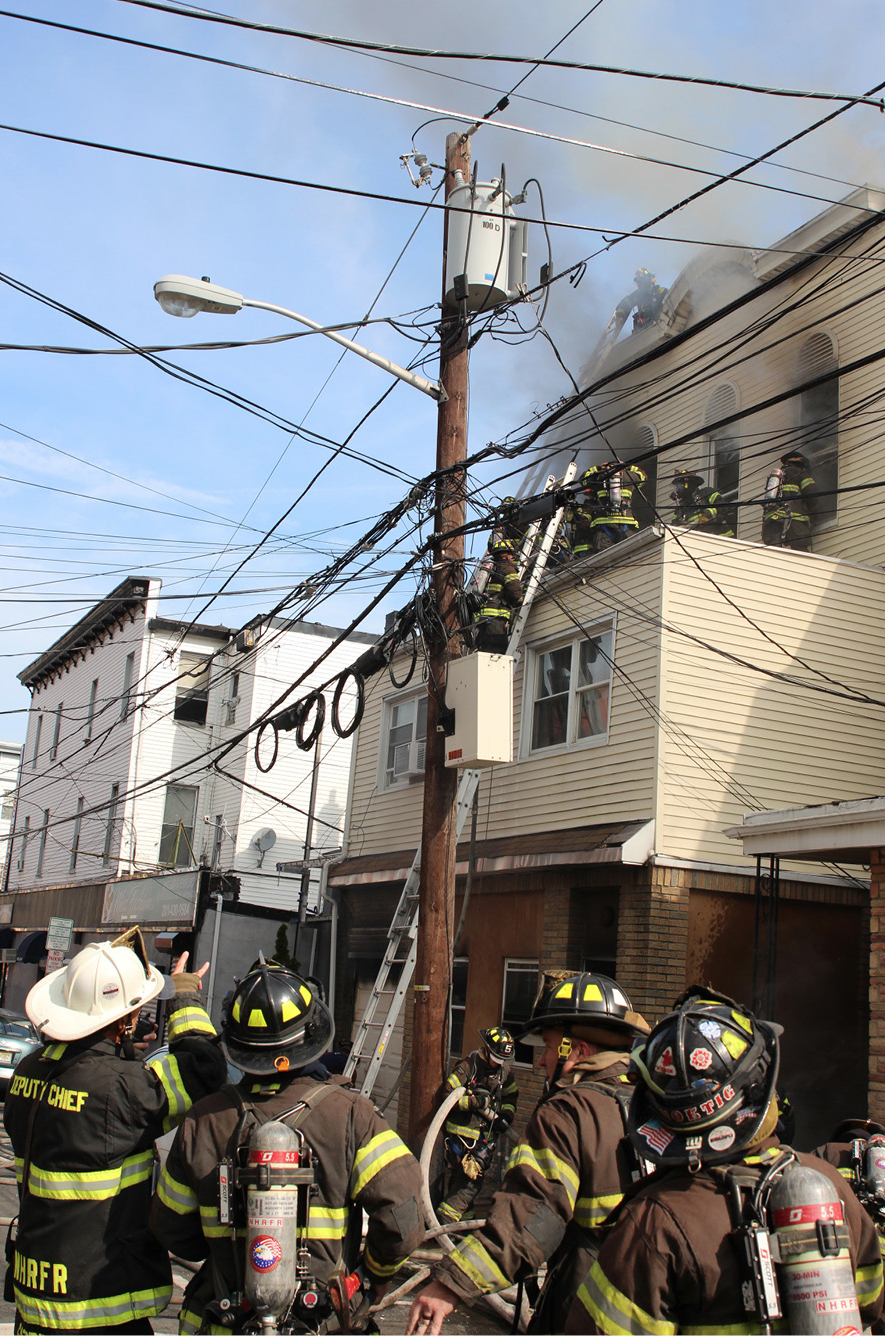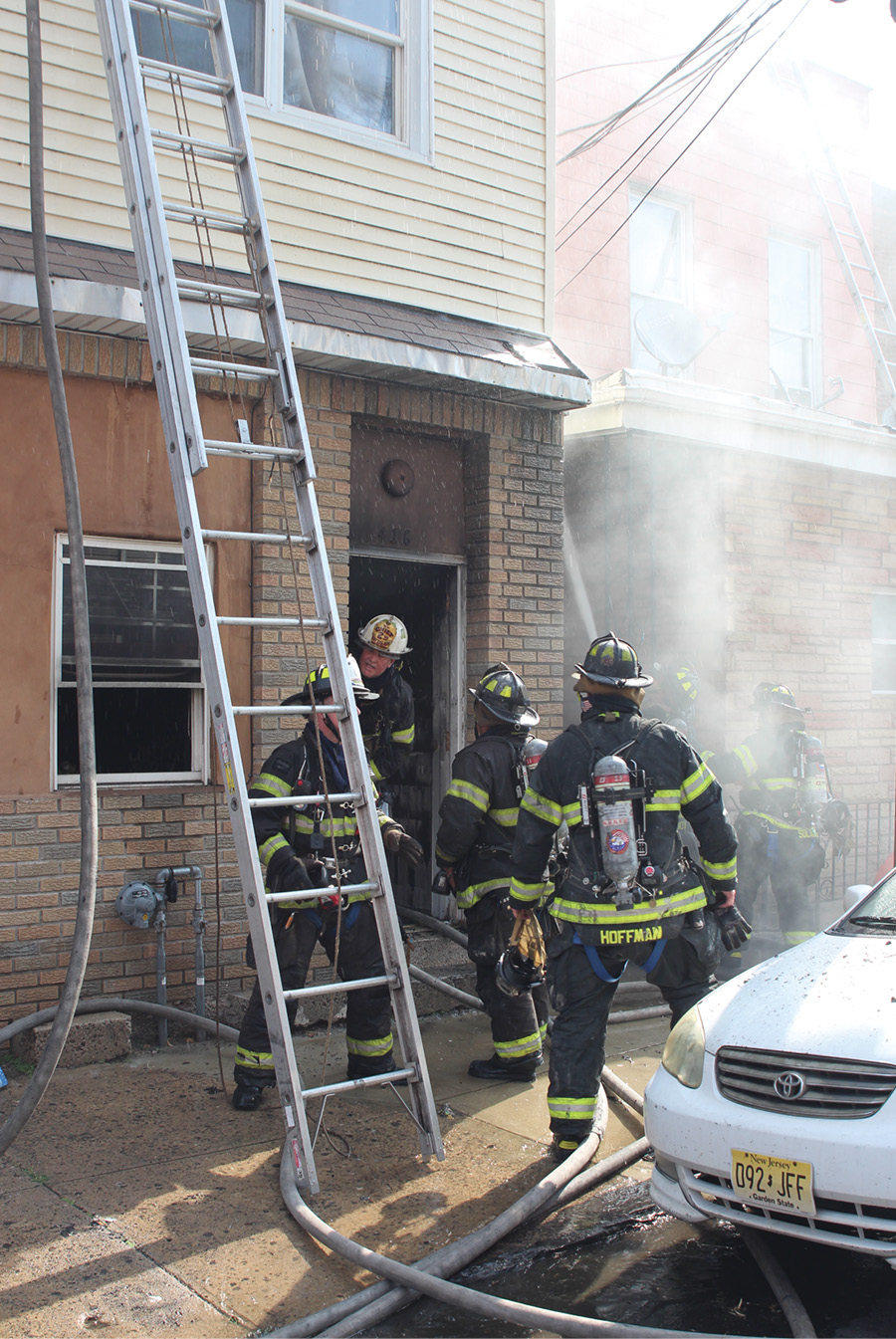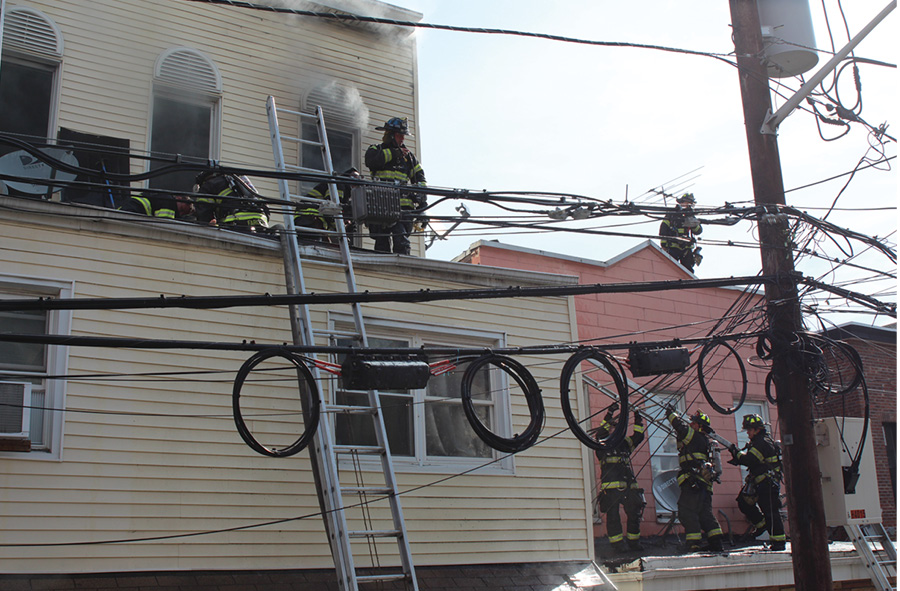
Michael M. Dugan
On July 13, 2018, fire alarms were received at 8:54 a.m. for a fire in Union City, New Jersey. North Hudson (NJ) Regional Fire and Rescue units responded. First units arrived on the scene at 8:57 a.m. and observed a heavy column of black smoke in the area of the reported fire, indicating that the fire had made significant headway. The reported address was 416 25th Street in Union City. The building was a three-story, wood-frame structure with a two-story bump-out in the front.


(1) A large column of black smoke was seen in the distance as units responded, indicating a working fire. This, plus numerous calls received by dispatch, dictated a full-alarm assignment for a working fire. (Photos by Ron Jeffers.) (2) The view as units were still responding in. Because of the change in the smoke, water was already being applied quickly to this fire.
The fire department members had an arduous task ahead of them. There were numerous calls reporting the fire and additional reports of people trapped. They received a full-alarm response for a working fire. This included four engine companies, two ladder companies, a rescue company, a battalion chief, a deputy chief, a safety officer, and a rapid intervention team. A second alarm was transmitted at 8:59 a.m., a third alarm at 9:00 a.m., a fourth alarm at 9:16 a.m., and a fifth alarm at 10:06 a.m. for relief and additional firefighting resources. The temperature was approximately 80°F. This, combined with the humidity and the amount of work that had to be done, had a debilitating effect on the operating forces. Therefore, rehab and relief companies were of utmost importance. Get the resources in place as soon as possible. You do not want to play catch-up.
The building, approximately 100 years old, had heavy fire throughout. The heavy smoke condition permeated the building and could be seen from blocks away. The main entrance was located on the A side near the D corner of the building. Heavy fire was out the stairwell landing window on the exposure D side that was extending to the exposure D building (414 25th Street); this was another concern that had to be addressed.

(3) Truck companies laddered the building and engine companies stretched lines. You can see from the exterior that windows have been replaced and plywood is visible. This might indicate additional living spaces in this structure.
Initial engine companies stretched two hoselines to the stairway to the upper floors of the building on the exposure A side of the building. Units encountered heavy fire in control of the stairway, limiting the use of the stairs for immediate rescue. A third handline of 2½-inch hose was stretched to knock down the fire on the exterior of the fire building and protect the D side exposure. Realizing the stairs were not usable, ladder companies and the rescue company started rescue operations using portable ladders. Because of the power lines in front of the fire building, all rescues had to use the interior stairs or the portable ladders. Members placed numerous ladders on the fire building and on the exposure D building.



(4) Because of overhead lines and their proximity to the fire building, all rescues had to be made using portable ladders or the interior stairs. (5) The fire vented out the exposure D stairwell window, igniting the siding and impacting the exposure D building. This fire was going to necessitate more resources. (6) Firefighters turned the victims over to emergency medical services and police, as they were needed to continue searching throughout the fire building. Cooperation among all first responders is critical in instances with mass casualties.
A quick-thinking company placed a ladder to the second-floor roof of the fire building from the one-story roof of exposure D. This allowed victims to be quickly brought to a tenable area for initial triage and cardiopulmonary resuscitation. This was out-of-the-box thinking that shows their knowledge of their buildings and their response area. Knowledge and preplanning again assist in successful fireground operations.
As you can see in some of the photos, the building appears to have been renovated; plywood and new windows are on sides A and B of the building. The renovation plus the fact that smoke that was pushing from around the garage door indicate the need to search all areas of the building for possible victims. You don’t know if renovations have been made to this building or if there are added living spaces. When you see indications of a change in space, you should always question what that space will be used for.
Companies removed six victims from the third floor—an incredible achievement. Members’ professionalism and dedication to duty were reflected in the fact that they stretched three handlines, placed numerous ladders, and performed six rescues. Companies are always in “rescue mode” and constantly drill on their standard operating guidelines (SOGs), which take into account their staffing and response areas. The engine companies drill on attacking the stairs, and all companies drill on the two-angle or two-sided approach to fighting fires and making rescues. Battalion-level drills on the SOGs paid huge dividends, as the members were able to do all these tasks at this fire and do them quickly.



(7) Two handlines were stretched to the interior stairs, which were fully involved on fire department arrival. A third handline was stretched to extinguish the fire and the outside of the building and protect the D exposure. (8) Additional ladders were raised to the second-floor roof of the fire building from the one-story bump-out on exposure D. This allowed for quick removal of the victims and space for additional victims. (9) Members worked together to get a victim down as quickly as possible.
As you can see in the photos, the black smoke quickly changed to gray when water was applied. Quick water enabled the stairs to be used for victim removal after the fire was knocked down.
Mutual-aid companies came from Jersey City, Hoboken, and Kearny. The fire was placed under control at 11:25 a.m. Six victims were removed—four children and two teenagers. Sadly, five of them passed away.
The members of North Hudson Regional Fire and Rescue did a tremendous job removing the six victims under grueling conditions and giving them at least a chance. The incident commander did an incredible job directing the members, and the members did an incredible job getting lines into place and removing victims using portable ladders and the stairs.

(10) Rehab for members is critical in a fire like this. Most members went through three air bottles during this operation. Taking care of our members post fire and getting them back in shape are critical to what we do.
The outcome of this fire was the result of the members drilling, working together, and putting their SOGs in place during a difficult fire. It was an amazing job done at a difficult fire. The members who responded to this fire should be proud of the effort they made to knock this fire down and make the rescues.
MICHAEL M. DUGAN is a 27-year veteran of the Fire Department of New York, where he served as captain of Ladder Company 123 before retiring in 2012. As a lieutenant, he served in Ladder Company 42 and was a firefighter in Ladder Company 43. He has been involved with the fire service for 39 years.

